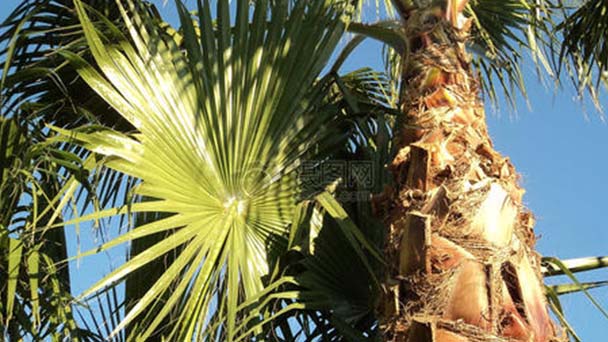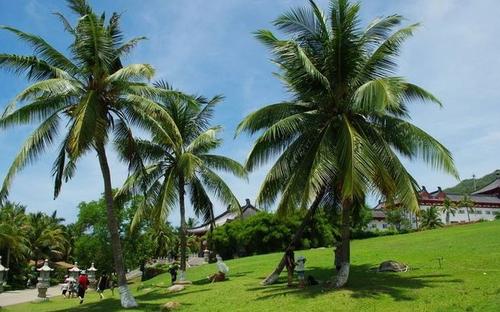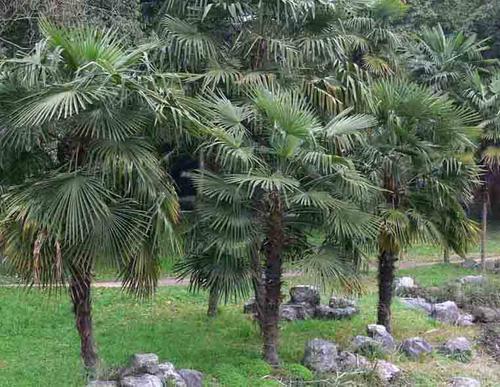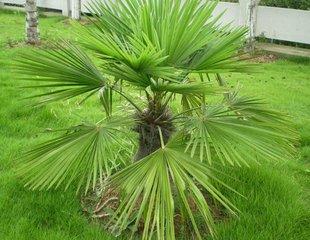Windmill Palm (Trachycarpus Fortunei) Profile
Written by Maggie
Nov 18 2022

Windmill Palm (scientific name: Trachycarpus fortunei) is an evergreen tree in the Windmill Palm family, with a height of up to 7 m. Stem is cylindrical, leaf blade nearly round, petiole on both sides with fine crenate, inflorescence stout, dioecious. Flowers are yellow-green, ovoid; The fruit is broad-kidney-shaped, has umbilicus, becomes pale blue from yellow when mature, has white powder, the seed endosperm is horny.
Windmill Palm Picture

Characteristics of Windmill Palm
Windmill Palm is arbor-shaped, 3 -- 10 m or taller, trunk cylindrical, with old petiole base and dense reticular fibers that do not fall off easily, unable to fall off without manual stripping, bare trunk 10 -- 15 cm or more in diameter.
Leaf-blade of Windmill Palm is 3/4 orbicular or suborbicular, deeply lobed into 30-50 wrinkled linear sword-shaped lobes, ca. 2.5 -- 4 cm wide, 60 -- 70 cm long, lobes apically 2-lobed or 2-toothed, stiff or even apically pendulous; Petiole is 75-80 cm or even longer, crenate on both sides, apically marked with a halberd process.
Inflorescences of Windmill Palm are stout, many-branched, drawn from leaf axils, usually dioecious. Male inflorescences ca. is 40 cm long, with 2-3 branched inflorescences, lower ones 15 -- 17 cm long, usually only bifurcated; Male flowers are sessile, every 2-3 flowers densely on the cob, but also solitary; Yellow-green, ovoid, obtuse trigonal; Calyx has 3 pieces, ovate acute, a few separate, corolla about twice as long as calyx, petals broadly ovate, stamens 6, anthers ovate arrow shaped; Female inflorescences of Windmill Palm are 80 -- 90 cm long, peduncles 40 cm long, enclosed by 3 spathe, with 4 -- 5 paniculate branches, lower branches 35 cm long, 2 -- 3 branches; Female flowers are pale green, usually 2-3 aggregates; Flowers are sessile, globose, growing on short tuberculate, sepals broadly ovate, 3-lobed, base connate, petals ovate nearly round, longer than one third of sepals, 6 stamens, carpel silvery hair. Fruit is broadly reniform, with umbilicus, 11 -- 12 mm wide, 7 -- 9 mm high, yellow to pale blue at maturity, with white powder, stigma remaining near the side. Seed of the Windmill Palm is endosperm uniform, horny, embryo lateral.
Habits of Windmill Palm
Windmill Palm is usually only cultivated in four, rare wild in the open forest, the upper limit of elevation is about 2000 meters; Although in the north of the Yangtze River can be cultivated, but the winter stem must be wrapped in grass to prevent cold.
Distribution of Windmill Palm
Windmill Palm is originally in China. Japan, India, Burma. Windmill Palm is widely distributed in China, starting from Shandong in the north, reaching Guangxi, Guangdong and Yunnan in the south, reaching the border of Xizang in the west, and reaching Shanghai and Zhejiang in the east. From the Yangtze River to the sea, along the upper reaches of the Yangtze River on both sides of the vast area of 500km is the most widely distributed. Windmill Palm distributes in the provinces south of the Yellow River.
Propagation of Windmill Palm
Sow propagation of Windmill Palm, in the place of origin can sow reproduction. In autumn fruit ripe, even ear cut, dry after thresh, with the best, or in the ventilated place after harvest dry in the shade, or line sand hiding, to the next year spring sowing, germination rate of 80%~90%. After sowing seedlings 2 years, change the bed for transplanting, when moving, cut off the leaf 1/2~1/3 shallow planting, so as to avoid rotten hearts and evaporation, ensuring survival. Spring sowing should be early, before sowing, soak 60-70℃ warm water for one day and night to accelerate germination, drill sowing, sowing amount of 750-1000 kg/ha, seed germination is slow, deep basin soil, good water retention effect, conducive to germination, seedling growth is slow, sheltered place maintenance or appropriate shading. Plant spacing 3 cm in the basin, 3 cm thick covering soil, every 2 to 3 days water; Buckle another flowerpot half cover shape, about 40 days can germinate, then remove buckle basin, weeding in time at seedling stage, loose soil, strengthen fertilizer and water management. The Windmill Palm grows slowly at the beginning. The height of the seedling is only 3cm in the current year. The bed is left in the next year, and the plant is grown in the third year. Windmill Palm is mostly planted on landscaping ground in cities south of the Yangtze River in China. It has strong adaptability. As long as there is no low-lying water and a 1-meter deep soil layer, Windmill Palm can be planted in moist and fertile neutral or slightly acidic soil. Don't plant in the wind, or the leaves will be broken. When seedlings stay more fibrous roots, seedlings can bear roots, seedlings need to take the earth ball, planting should not be too deep, otherwise easy to cause rotten hearts. In order to reduce water evaporation and improve the survival rate of large seedlings, 1/2 of their leaves should be cut off when transplanting. New leaves occur, such as old leaves sag, should be cut off in time, other management is more extensive.

How to Plant Windmill Palm
Cultivated soil requires good drainage and fertility. Windmill Palm has a shallow root system without a taproot, so it should not be planted too deep. After planting, the whole surface should be kept in the shape of a plate.Windmill Palms grow very slowly in the early stages and require proper shade. It takes three to five years for the stem to rise to the surface, three to four years for the normal palmate-shaped, wrinkled leaves, and more than eight years for the plant to grow. At this point, the palmetto is only 1.3 to 1.5 meters high. This slow growth process is especially evident when the plant is exposed. The same soil and variety grew more well at 1/4 to 1/5 light intensity than at 1/2 light intensity. Before putting into production, the characteristics of the annual growth process are long term, small growth amount and not obvious fast growth period. In the early stages, this trait of Windmill Palm is largely consistent across breeds. In order to accelerate the growth of the Windmill Palm, a longer period of continuous management is required throughout the infancy. Especially from spring to autumn of the year when new leaves were growing, the height and diameter growth of Windmill Palm were almost in the same period, and the initial growth mainly depended on the supply of photosynthate accumulated in the earlier period.
Windmill Palm Seed Storage
Seed of Windmill Palm is often from 15-40 years old mature trees, young trees and old trees should not be used seeds. Harvest in autumn, when the palm seed is fully mature and grey. Plant solid after removing the branchlet stem, put in the room, shop 12-15 cm thick, stall air 15 days or so, and can sow. If waiting for spring sowing should be mixed seeds and wet sand, spread indoor, cover with a layer of straw, keep wet storage.
Site Preparation
Plant nurseries should choose fertile sandy or clayey loam soils that are close to water sources and less susceptible to drought and flooding. General every 7 square meters of decoction of human excrement 8-10, 20 kilograms of calcium superphosphate, ploughing, made of 1.4 meters wide bed, the whole broken bed surface soil blocks, you can sow. Before sowing, the seeds of Windmill Palm should be soaked in plant ash water for 48-64 hours, wipe off the peel and wax outside the seeds, and wash the seeds. Because the germination rate of palm-tree seed has 40% or so only commonly, reason should sow sufficient seed, every 667 square meters sow 50-60 kilograms. Drill seeding, strip spacing 20-25 cm. After sowing with ash dung and finely mixed fertile soil and feces, cover the seeds, not too thick, with 2-2.5 cm as a degree. Then a layer of rice (wheat) grass is placed on top to prevent the soil from drying and hardening.
Windmill Palm Seedling Stage Care
More than 80% seedlings in the evening will cover grass lift, spray wet bed surface with a spray can.Keep the soil moist during the seedling period and pull out weeds in time. A month after the emergence of seedlings, every 7 square meters with 2 kilograms of urea on the water pouring application. After 3-4 months, when the seedlings have three leaves, a Windmill Palm will be planted. Fake soil is loose and fertile, every 667 square meters of soil fertilizer 80-10. Planting row spacing 15 cm x 13 cm, every day after planting the evening to water, until survival. A month later, the soil began to lose topdressing. In the season of high temperature, beat the palm-grass stalks among the seedlings for shade. Seedling height about 60 cm, can be transplanted.
Transplanting Windmill Palm
Choose wet and fertile soil, good drainage slope at the foot of the hill, especially in the field, the edge of the house, the stream bank, roadside and other free land is better. Low - lying land, heavy clay, dead yellow mud, acid and alkali, shallow soil are not suitable for planting. plant windmill palm in pieces, in summer of the year before transplanting, all the weeds and shrubs on the ground were cut down, dug about 30 cm deep, and the weeds and shrubs were buried in the soil; To be transplanted, break the soil block, pick up in addition to stones, tree roots, dig holes afforestation. The depth, length and width of the hole were 30 cm, the spacing of the rows was 17 meters and 1.3 meters, and about 30 Windmill Palms were planted every 667 square meters. Spreadingly planted, to 20. Persuade from, in the transplanting place to dig holes, holes 30-35 cm deep, hole length and width of 40 cm, 2 meters apart, do the street tree spacing should be more than 3 meters. Because the brown seedling has no taproot, the fibrous root group extends to the four sides, so some soil should be laid in the center of the bottom of the hole, so that it is higher than around. When planting, the seedling stem stands in the middle of high place, fibrous root incline extends to all around the low place, then fills soil to trample solid. Attention should not be planted too deep, to prevent the heart of the seedlings buried in the soil. Cue deep seedlings small, can be filled at the bottom of the hole some of the soil or fertilizer. After transplanting, fertilizing every 2-3 years, applying fire dung, garbage, soil and other miscellaneous dung. Pay attention to drainage to prevent debt, in case of death of root rot. And attention should be paid to remove the moss ringworm, lichen and knee tendrilla on the trunk in time.
Potted Windmill Palm
Potted Windmill Palm can also be grown in the north. Plants under 6 years old can be potted. Plants 8-9 years old should be planted in wooden barrels. More than 20 years of growth is greatly reduced, old leaves withered yellow easy to lose ornamental value, should be eliminated. Water Windmill Palm 1 times a day in hot summer. Spring and autumn watering times some less had better. In autumn in the north to enter the low temperature greenhouse for winter, in spring to move out. Water more than 10 days 1 time. After 2-3 years, seedlings are transplanted, and the survival rate is high when transplanting in spring. Remove some of the Windmill Palm leaves before removal and plant lightly to avoid burying the growing points. After 5 years of accelerated growth, Windmill Palm can be planted or on the pot. Sand loam soil was selected for planting, and sufficient organic fertilizer was applied. Windmill Palm is a plant with strong stress resistance and easy cultivation and management.It likes to grow in moist, fertile and well drained neutral soil, but it also grows well in acidic and slightly alkaline soil.The tree can withstand the low temperature of -10℃ or so. The illumination requirement is not strict, can grow well under the full sunshine, and can grow well in the more cloudy indoor. Windmill Palm also has a certain drought resistance and moisture resistance, so the seedling potted ornamental maintenance management can be slightly extensive. Windmill Palm also has strong resistance to sulfur dioxide, hydrogen fluoride and other toxic gases, so it can be widely planted or potted in the indoor and outdoor greening of the factory, so as to play a good role in improving the environment and reducing pollution.
Disease Control of Windmill Palm
More from the base of the petiole began to occur, the first production of yellow brown spots, and along the petiole up to the leaf, the disease gradually withered. The extension of the disease spots and the trunk produced purplish brown disease spots, resulting in discoloration and necrosis of the vascular bundles, and the trunk rotted. Leaves wither and Windmill Palms die. If the young tissue rotted at the dry tip of the Windmill Palm, it would be more serious. Many white mycelia are common at the base of dead petioles and on rotten leaves. When the upper part dies, the underground root system soon rots and dies. The pathogen was Penicillium.
Prevention and control measures: timely removal of dead and seriously ill strains of Windmill Palm, to reduce the source of infection. Timely and appropriate peeling, not autumn peeling too late, spring peeling too early or too much peeling. In spring, it is generally appropriate to peel brown before and after Tomb-sweeping Day. It can be sprayed with 50% carbendazim 500 times liquid, or applied after scraping off the disease spots, and it has certain prevention and treatment effects.
Find more details on how to grow and care for Windmill Palm.
Windmill Palm Benefits
Windmill Palm is widely cultivated in the south, mainly peel its brown fiber (leaf sheath fiber), as a rope, coir coir, brown stretch, carpet, brush and as a sofa filler; The young leaves can be bleached to make fans and straw hats; The closed buds, also known as "brown fish", are edible; Brown bark and petiole (brown plate) calcined charcoal medicine has hemostasis effect, fruit, leaves, flowers, roots, etc. In addition, Windmill Palm has a beautiful tree shape and is also an excellent tree species for garden greening.
Medicinal
Windmill Palm can be used as a hemostatic.
Botanical Garden
Windmill Palm is tall and beautiful, with a southern scenery, strong adaptability, and can resist a variety of toxic gases. Brown leather is widely used, demand exceeds supply, so the garden combined with the production of ideal tree species, but also the factory green excellent tree species. Windmill Palm can be planted in rows, clusters or patches, and can also be planted in pots or barrels for indoor or building decoration and venue layout.
Economic
The leaf sheath fiber of brown leather has strong tensile resistance, wear resistance and corrosion resistance, weaving coir raincoat, fishing net, rope, brush making tools, carpet and mattress, etc. Old leaves can be worked into ropes. Trunks of Windmill Palm can be used as a pavilion column, sink, but also fan bone, comb and so on. Tender scapes of Windmill Palm are edible. Flowers, fruits and seeds of Windmill Palm are used as medicine. Seeds of Windmill Palm are rich in starch and protein, which make them a good feed after processing.

Latest Updated
- Benefits of Bugleweed - 7 Science-backed Health Benefits
- Bugleweed Dangers & Side Effects - Is It Poisonous?
- How to Plant Evergreen Trees - What You Should Know
- When to Plant Evergreens - Grow Guide for Evergreen Trees
- 12 Wonderful Evergreen Shrubs for Your Garden
- 12 Popular Evergreen Plants with Pictures for Beginners
- When And How To Prune A Lilac Bush Like a Pro
- How to Grow & Care for Lilac Vine (Hardenbergia Violacea)
- Japanese Lilac Tree (Syringa Reticulata) Care & Propagation Guide
- Shumard Oak Pros and Cons - What to Know
Popular Articles
- Winter maintenance of Antirrhinum Majus
- How to Grow Terminalia Mantaly Tree
- How to Grow and Care for Crossostephium Chinense
- How to grow Antirrhinum Majus in spring
- Peristeria Elata (Dove Orchid) Profile: Info & Care Guide
- Underwatered Snake Plant (Sansevieria Trifasciata) - Signs And How To Fix
- How to Care for Brazilian Jasmine Plant (Mandevilla Sanderi)
- How to Grow & Care for Graptopetalum Purple Delight in Summer
- Rosa Chinensis (China Rose): Plant Growing & Care Tips
- How to Care for Baby Sun Rose (Aptenia Cordifolia)